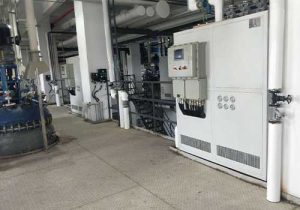split chiller
Split Chiller: A Comprehensive Guide
Introduction
A split chiller is a cooling system that consists of two separate units: an indoor unit (evaporator) and an outdoor unit (condenser). These units are connected by refrigerant lines, allowing for flexible installation and efficient heat transfer. Split chillers are widely used in residential, commercial, and industrial applications due to their energy efficiency, quiet operation, and space-saving design. This article delves into the working principles, components, advantages, applications, and considerations for selecting a split chiller.

Working Principle
A split chiller operates on the vapor-compression refrigeration cycle, which involves four main components: the compressor, condenser, evaporator, and expansion valve.
Compressor: Located in the outdoor unit, the compressor pressurizes the refrigerant gas, increasing its temperature and pressure.
Condenser: Also in the outdoor unit, the condenser cools the high-pressure, high-temperature refrigerant gas, causing it to condense into a high-pressure liquid.
Expansion Valve: The high-pressure liquid refrigerant passes through the expansion valve, where its pressure is reduced, causing it to partially evaporate and cool.
Evaporator: Located in the indoor unit, the evaporator absorbs heat from the space or process fluid, causing the refrigerant to evaporate completely. The low-pressure gas is then returned to the compressor to repeat the cycle.
The separation of the indoor and outdoor units allows for flexible installation and efficient heat transfer.
Key Components of a Split Chiller

Indoor Unit (Evaporator): The indoor unit contains the evaporator and is responsible for absorbing heat from the space or process fluid.
Outdoor Unit (Condenser): The outdoor unit contains the compressor and condenser, which dissipate heat to the environment.
Refrigerant Lines: These lines connect the indoor and outdoor units, allowing the refrigerant to circulate between them.
Control System: The control system regulates the temperature, flow rate, and pressure within the system, ensuring optimal performance.
Advantages of Split Chillers
Energy Efficiency: Split chillers are designed to be energy-efficient, reducing operational costs and environmental impact.
Quiet Operation: The separation of the indoor and outdoor units reduces noise levels, making split chillers ideal for noise-sensitive environments.
Space-Saving Design: The compact design of the indoor unit saves valuable floor space, while the outdoor unit can be installed in a convenient location.
Flexible Installation: The ability to separate the indoor and outdoor units allows for flexible installation in a variety of settings.
Precise Temperature Control: Split chillers provide precise temperature control, ensuring optimal performance and comfort.
Applications of Split Chillers
Residential Use: Split chillers are used in homes for air conditioning and cooling small spaces.

Commercial Use: These chillers are used in office buildings, retail stores, and restaurants for cooling and temperature control.
Industrial Use: Split chillers are used in manufacturing plants, data centers, and laboratories for cooling equipment and processes.
Healthcare Facilities: Hospitals and medical centers use split chillers to maintain precise temperatures for medical equipment and storage.
Educational Institutions: Schools and universities use split chillers for cooling classrooms, laboratories, and data centers.
Considerations for Selecting a Split Chiller
Cooling Capacity: Determine the required cooling capacity based on the heat load and temperature requirements of the application.
Energy Efficiency: Look for chillers with high energy efficiency ratings and advanced control systems.
Noise Levels: Consider the noise levels of the outdoor unit, especially if it will be installed near noise-sensitive areas.
Space Constraints: Evaluate the available space for the indoor and outdoor units and choose a system that fits comfortably.
Installation Requirements: Consider the installation requirements, including the length of refrigerant lines and the location of the outdoor unit.
Maintenance Requirements: Opt for systems with low maintenance requirements and easy access to components for servicing.
Conclusion
Split chillers are a versatile and efficient cooling solution designed for a wide range of applications in residential, commercial, and industrial settings. Their separation of indoor and outdoor units allows for flexible installation, quiet operation, and space-saving design. By understanding the working principles, components, advantages, and selection criteria, users can choose the right split chiller to meet their specific needs. This guide provides a comprehensive overview of split chillers, equipping readers with the knowledge needed to make informed decisions about reliable and flexible cooling solutions.
Related recommendations
How to Reduce the Operating Cost of Air-cooled Chillers?
1233How to Reduce the Operating Cost of Air-cooled Chillers? In life, we are all advocating energy saving and environmental protection, and air-cooled chillers are no exception. The chillers pur...
View detailstexas chillers
481Texas Chillers: A Comprehensive Look Introduction Texas, with its large geographical expanse and diverse climate conditions, has a significant need for efficient cooling solutions. Chiller...
View detailsheat temperature control
825Introduction to Heat Temperature Control Heat temperature control is essential in various industries to maintain optimal conditions for processes, ensuring efficiency, safety, and quality of pr...
View detailsair cooling unit uk
750Air Cooling Units in the UK: Types, Applications, Maintenance, and Environmental Impact The United Kingdom experiences a temperate climate with warm summers, making air cooling units a popular ...
View details
 LNEYA Chiller
LNEYA Chiller







HelloPlease log in